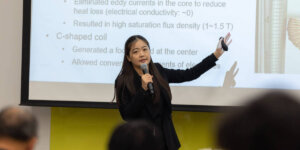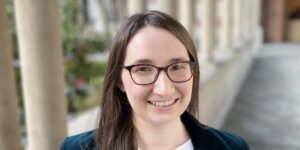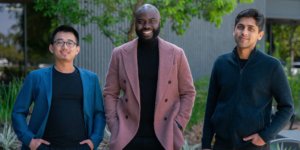
ANTONINA MAXEY (L) AND NATALIE KHALIL (R) WERE AWARDED NSF GRADUATE RESEARCH FELLOWSHIPS FOR THEIR WORK IN LIVING SYSTEMS ENGINEERING. IMAGES/ANTONINA MAXEY AND NATALIE KHALIL
Ph.D. students in the USC Viterbi Department of Biomedical Engineering, Antonina (Nina) Maxey and Natalie Khalil have been awarded prestigious Graduate Research Fellowships from the National Science Foundation. The competitive five year fellowships honor outstanding graduate student researchers with financial support, including an annual stipend of $34,000.
Maxey and Khalil are both working within the department’s Laboratory for Living Systems Engineering, led by Chonette Early Career Chair and associate professor of biomedical engineering, Megan McCain. Maxey’s work explores the behavior of muscle cells in the uterus, while Khalil examines the scarring of tissue after heart attacks.
We spoke to Maxey and Khalil to find out more about their research.
Antonina Maxey
Where are you from?
Los Angeles, California. I grew up 15 minutes away from USC’s campus!
When did you first realize that you wanted to study engineering?
I always enjoyed math and science, so I selected bioengineering in college because it seemed like a good blend of the two fields. My research at the University of Pittsburgh and experience in the medical device industry confirmed that I found a field that I truly enjoy.
How does it feel to be the recipient of an NSF Graduate Research Fellowship?
I was really happy to learn that I received the NSF Graduate Research Fellowship. I am so appreciative of Dr. McCain, my mentors, lab mates, friends, and family for their support during the application process.
Could you describe your research focus?
Dr. Megan McCain’s Laboratory for Living Systems engineering specializes in developing physiological in vitro models with quantitative outputs for contractility. My research focuses on the contractions of smooth muscle cells from the uterus. Specifically, I will evaluate how chemical and mechanical stimuli regulate their contractility. This research can inform broader questions related to preterm and insufficient progression of labor.
What excites or inspires you most about your area of research?
Although one might assume that the details of childbirth would be very well understood by now, there is still much to be uncovered. I am excited to use the intersection of biology, medicine, and engineering to contribute to the field.
Natalie Khalil
Where are you from?
I was born in San Diego, California, although my family is originally from Lebanon.
When did you first realize that you wanted to study engineering?
I have always enjoyed problem solving and began my undergraduate studies as a mathematics major. After taking an introductory biology course, I next switched majors into biomedical engineering.
How does it feel to be the recipient of an NSF Graduate Research Fellowship?
I feel very grateful for my mentors who have inspired me to pursue graduate research. This fellowship really reflects the support and encouragement I have received from Prof. Megan McCain, previous mentors, and colleagues in the Laboratory for Living Systems Engineering at USC.
Could you describe your research focus?
A heart attack is accompanied by oxygen gradients that bridge healthy and injured tissue. It is not completely understood how oxygen gradients regulate fibrotic scarring after a heart attack, in part due to shortcomings of existing research tools, which are mostly limited to exposing cells to a single, global oxygen level. To address this gap, we are engineering and implementing microfluidic devices to mimic oxygen gradients after a heart attack and explore oxygen-dependent signaling in cardiac fibroblasts. This work may identify new therapeutic targets to mitigate scarring after a heart attack.
What excites or inspires you most about your area of research?
When I took Prof. McCain’s course in tissue engineering as a junior undergraduate student, I was inspired by the applications of tissue engineering principles, such as gene-editing, bioprinting, and microfluidic devices, towards solving problems in medicine. I am most excited about the potential of microphysiological systems to model human disease and elucidate pathological mechanisms.
Published on May 20th, 2021
Last updated on May 20th, 2021











